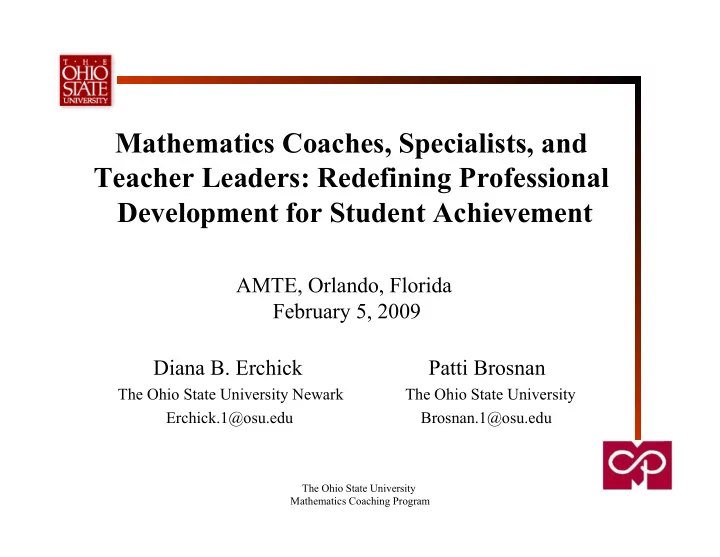

Mathematics Coaches, Specialists, and Teacher Leaders: Redefining Professional Development for Student Achievement AMTE, Orlando, Florida February 5, 2009 Diana B. Erchick Patti Brosnan The Ohio State University Newark The Ohio State University Erchick.1@osu.edu Brosnan.1@osu.edu The Ohio State University Mathematics Coaching Program
Today’s Focus • Mathematics Coaching Program Framework and evaluation model • Selected instruments, data, and findings • Audience Sharing of research experience • Discussion of further directions for coaching work research, issues, potentials, Q&A The Ohio State University Mathematics Coaching Program
MCP Structural Model Project Directors, Facilitators Coach Technical Assistance Team: Students School Teachers (district hire) and Support Personnel Coach School Students Teachers (district hire) Coach School Students Teachers (district hire) The Ohio State University Mathematics Coaching Program
Evaluation Research Coach Level Teacher Level Student Level LMT (UM) LAMP (MCP/OSU) OATs – Public Record LAMP (MCP/OSU) Coach Reports/1-on-1 OATs – MCP Pre/Post Facilitator Reports Coach Reports/Classroom Problem Sets Coach Reports In Development - 09-10: Coach Report/Classroom Site visits Classroom Observation Primary Grades Coach Interviews Teacher Interviews In Development - 09-10: Scripting/Scenario Social Justice Classroom Observation Prompt Implementation Social Justice: Coach Development PD documentation The Ohio State University Mathematics Coaching Program
Learning About Mathematics Pedagogy LAMP • Purposes – content and pedagogy • Model of first LAMP – 10 items, based on student work, all open response • Emergent themes • Model of current LAMP – 10 items, based on student work, each with 2 forced response and corresponding elaboration The Ohio State University Mathematics Coaching Program
Lamp Theoretical Grounding Emergent themes led to fixed responses ranked from least to most desirable: • Content: – Procedural to Integrated Procedural/Conceptual (Baroody et al) • Mathematics: – Direct instruction to learner-responsive pedagogy The Ohio State University Mathematics Coaching Program
Sample LAMP Mathematics Item 9. Students were asked to tell a story to go with the graph below. Maris’ story was about a sailboat’s speed in a race. From the options below, select and circle the one that best represents Maris says when what you believe Maris' response the graph gets flat, it means the I indicates she understands and does not boat stopped. understand: a) If Maris had more information on the graph she may have interpreted it differently. b) Maris must not understand how to use numbers and labels in her graphs. c) Maris does not understand that the straight line indicates that the speed remains the same over time. d) Maris understands that a line graph shows only a progression of time, rate, or speed. The Ohio State University Mathematics Coaching Program
Sample LAMP Mathematics Item The teacher/coach chose c ( Maris does not understand that the straight line indicates that the speed remains the same over time) and elaborated as follows: If the boat stopped the graph would go down to the bottom where zero would be. The graph shows speed, where the boat is speeding up, remaining steady at a constant speed, and then accelerating again. The Ohio State University Mathematics Coaching Program
Sample LAMP Pedagogy Item Suppose you have 3 marbles in a bag: 1 red and 2 green. If you reach into the bag without looking and randomly pick out 2 marbles at once, what is the probability that both of the marbles you pick will be green? Jack said the answer is 2/3. From the options below circle the instructional strategy that best represents what you might use to teach students to understand probability: a) Ask Jack how he decided that 2/3 is the answer. b) Teach a lesson where students explore experimental probability so students can understand “likelihood.” c) Play games of chance. d) Tell the students the more there is of the color the more likely it is to be drawn. The Ohio State University Mathematics Coaching Program
Sample LAMP Pedagogy Item The teacher/coach chose C (Play games of chance) as preferred instructional strategy and elaborated as below: I would probably actually do the activity and ask them to list what they pull out. Then I would ask students what were the possibilities which would be red-green and green- green. From there they should be able to figure that the probability of choosing 2 green marbles is ½ . The Ohio State University Mathematics Coaching Program
Ohio Achievement Tests (OATs) • Designed to align with Ohio Academic Content Standards based on NCTM Standards by grade level. • Given once per year in April (Mar/May) • Release full test only after first administration. • Pre/Post Data collection and analysis The Ohio State University Mathematics Coaching Program
Extended-Response Problem • Twelve students wrote their names and the number of letters in their names on cards as shown. Tommy Elli 5 4 • Use the line to construct a line plot of the information on the students’ cards. Use X to show the data. 2 3 4 5 6 7 8
Discussion • Inter-rater reliability • Teacher interference • Technology skills • Move to public record data only • Pre/Post vs Year to Year The Ohio State University Mathematics Coaching Program
3rd Grade Mathematics Ohio Achievement Test Results Percentage at or above Proficient
Percentage at or above Proficient 3rd Grade Results by Ethnicity
3rd Grade Results by Economic Status Percentage at or above Proficient
Challenges • Requires a special kind of person. • Build relationships: trust, confidentiality. • Must have commitment to all of MCP. • Coach selection process. • IRB Issues. • RANDOMIZATION CONTROL The Ohio State University Mathematics Coaching Program
Discussion • Audience participants’ sharing • Further directions for coaching work research? • Needs and potentials? • Q&A The Ohio State University Mathematics Coaching Program
Thank You!!! The Ohio State University Mathematics Coaching Program
Recommend
More recommend